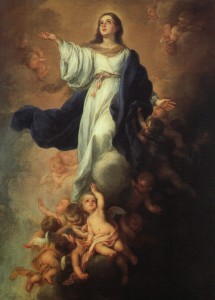
August 15 – The Assumption of Our Lady

There is great interest today in fantasy literature, in magical and enchanted stories, whether about Harry Potter or Narnia or the Lord of the Rings. Bookshops are full of material like this as well as science fiction and other kinds of imaginative writing. The desire for enchantment is a desire for other levels of life, that there might be other possibilities for humanity.
Today’s feast of the Assumption of Mary into heaven, her being taken up body and soul to the glory of Her Son’s kingdom, meets this desire in us for a level of life that transcends the ordinary realities, a thirst for something beyond, or beneath, or within the things immediately seen, the things easily comprehended and manipulated by us. Fantasy speaks, however faintly, to our sense of wonder about hidden mysteries.
The first reading for example, from the Book of Revelation, presents us with a dramatic story full of symbols, perfect for nourishing the artistic and poetic imagination. The newborn child is Christ and the woman who gives birth is Mary. But she is also the Church, the community of the followers of Christ, destined to follow a difficult road in this world. How the imagination thrills at an adventure, a quest, a search for hidden treasure. The road is rich with possibilities but it is also dangerous and there are many obstacles to be overcome. It is a work of the apocalyptic imagination but it is a true fantasy, if we can put it like that, an accurate diagnosis of the situation of the Christian in the world, of the promise which is our treasure, of the dangerous adventures of the way.
In the second reading Saint Paul teaches us that the new life, the life of the resurrection, already established in Jesus Christ in the moment of his resurrection – this new world and new creation is not just for Jesus but has been won by him for us. The great grace of the Christian faith is this, to accept the promise of a level of living which reaches beyond our imagination. The assumption of Mary is the guarantee of this: the new creation is not just for Christ but is for all who belong to him, in the first place Mary who is next to him in all things, but eventually to all Christ’s people. Mary, according to the preface of today’s Mass, is thus ‘a sign of hope and comfort for God’s people on their pilgrim way’.
The gospel includes Mary’s great prayer, the Magnificat, praising God for all His graces. Mary, an historical and particular woman, is a unique individual with a unique role in the drama. But she is ‘full of grace’ and so also a symbolic figure, representing the Church and all who are with her in the Church. The preface speaks of her as ‘the beginning and pattern of the Church in its perfection’. Symbolizing and realizing this perfection she is fittingly called ‘Mother of the Church’.
Already during this pilgrimage to the land sought by the Christian imagination, we see signs of the new creation, sparks of the glory that is to come, premonitions of the dawn. Wherever there is compassion, work for justice, care of the poor, unexpected generosity, faithful love, spontaneous and creative benevolence – in all of this we detect the presence of the Spirit for these are the effects of His life-giving love. Mary, whose following of her Son was marked by all these things, is the most beautiful creation of the Spirit, the highest honour of our race.
For the moment these signs and sparks encourage us to continue and to persevere on our pilgrimage. The full and clear revelation is yet to come. We continue to thirst, to desire and to imagine, living in the hope of the resurrection that is still to come. We are comforted and strengthened beyond measure by the prayers and example of Mary, already assumed into heaven, our life, our sweetness and our hope.


